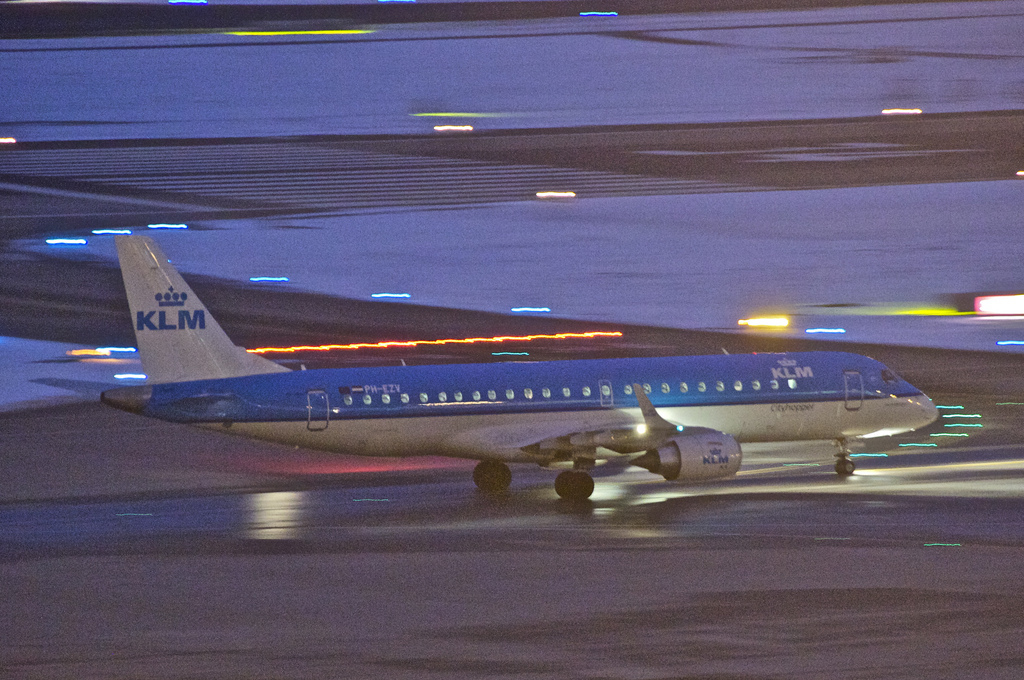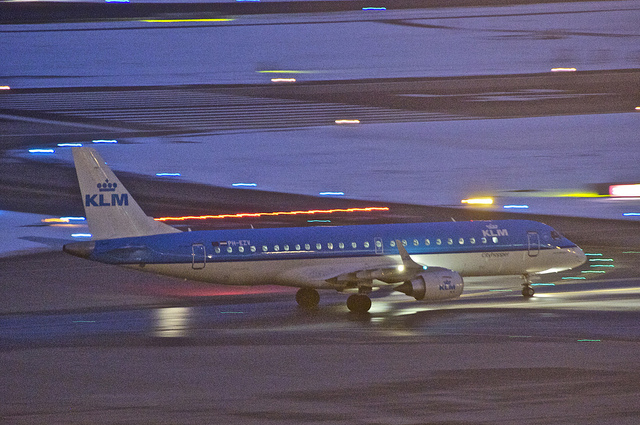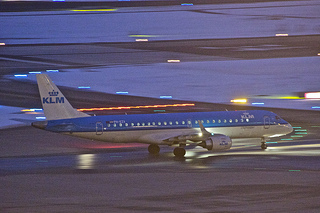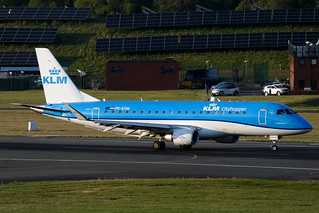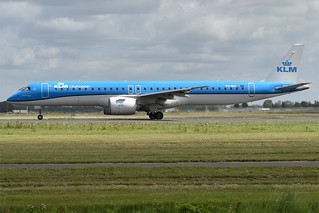KLM Cityhopper E190 at Amsterdam on Oct 1st 2014, hard landing after automatic approach
Last Update: May 31, 2016 / 14:01:36 GMT/Zulu time
Incident Facts
Date of incident
Oct 1, 2014
Classification
Report
Cause
Hard landing
Airline
KLM Cityhopper
Flight number
KL-1350
Departure
Prague, Czech Republic
Destination
Amsterdam, Netherlands
Aircraft Registration
PH-EZV
Aircraft Type
Embraer ERJ-190
ICAO Type Designator
E190
The Dutch Onderzoeksraad (Dutch Safety Board DSB) released their final report concluding the probably causes of the accident were:
The crew were incorrectly under the impression that they had configured the aircraft for an automatic landing. The indications of the automatic pilot did not lead the pilots to suspect that the aircraft was actually configured for a manual landing. The flight mode announciators (FMA) indications that they saw during the approach were what they were used to seeing. Moreover, the aircraft was in a valid configuration, which meant no error messages were generated. As a result, both pilots had no reason to think that the aircraft was not flying in the correct mode for an ILS Category I approach followed by an automatic landing. The aircraft did not perform a landing flare and made a hard landing.
The fact that the Cockpit Voice Recorder was no longer available has had adverse effects on reconstructing events and gaining insight into the crew’s considerations prior to the hard landing. The crew’s recollections of the incident have faded and/or may have been influenced by more recent flight experiences. The procedures for reporting incidents described in the airline’s operations manual leave room for interpretation regarding which incidents should be reported and what follow-up actions are required. This results in the loss of important sources of information for the investigation of incidents.
The DSB described the functions of the automatic approach of the ERJ-190:
When set to BARO prior to the start of the final approach, the autopilot will be able to perform an ILS CAT I approach up to the minima. When the intention is to make a manual landing, the automatic pilot on the Embraer 190 must be switched off at no lower than a radio altitude of 50 feet, regardless of the type of approach. If the latter is not done, the aeroplane will fly into the runway. If upon reaching the minima there is insufficient visual reference, a missed approach should be initiated.
To perform an automatic landing, the reference must be set to radio altitude (RA) and the flaps to position 5 before the start of the automatic ILS approach. Only after the AUTOLAND function has been activated (when the aeroplane is at an altitude of between 1,500 and 800 feet on the ILS glide slope) the pilot should set the BARO/RA selection knob to BARO in order to make the correct ‘minimums’ call.
In addition, the DSB reported, that the autopilot would not perform an automatic landing (including flare), if the flaps are set to FULL, the automatic landing including flare only engages with the flaps set to position 5.
The DSB analysed with respect to the reasons for the hard landing:
In a Category I autoland, the landing is initiated at 50 feet above the runway by the autopilot activating the landing flare. This manoeuvre increases the aircraft’s nose position, which reduces the rate of descent. The autothrottle then closes the throttles at 30 feet above the runway. This further reduces the rate of descent until the main landing gear contacts the runway. In a Category I approach without autoland, the automatic landing flare is not performed; however, the throttles may nevertheless close, depending on the selected settings. The QAR record shows that during the occurrence the throttles were closed between 48 and 34 feet above the runway threshold.
At roughly 50 feet above the runway threshold, the captain realised that the aircraft was not going to perform the intended landing flare. Due to the selected configuration, the autopilot had kept the control column and the elevator in practically the same position. As a result, the aircraft’s nose position also remained more or less constant at 1.6 degrees above the horizon.
The automatic pilot switches off if a large amount of force is applied to the control column in a short period of time in a direction that is contrary to the control signals from the automatic pilot. The QAR record shows that the automatic pilot disengaged below a height of 9 feet, but before the wheels touched the ground. The captain’s statement that he pulled back on the control column in an attempt to reduce the rate of descent is thus confirmed by the QAR record.
The tractive force on the control column appeared to increase to twice the value for a normal landing. Immediately after the automatic pilot automatically disengaged, the position of the control column and the elevator changed and the aircraft’s nose position increased. This could not prevent the aircraft from making a hard landing with a force 2.78 times gravitational acceleration.
As a result of the valid yet unintended configuration, the system gave no warning that warranted earlier intervention by the crew. There was thus no reason for the crew to have initiated a go-around, for instance, during the final approach.
The QAR data shows that the aeroplane’s pitch increased to 8.6 degrees above the horizon after the landing, after which the Captain landed the nose wheel. The Captain stated that the aeroplane could be steered properly during the roll-out on the runway and when taxiing to the aircraft stand.
With respect to the BARO/RA knob the DSB analysed:
The QAR record shows that while flying the final approach course an FMA indication was displayed for an ILS Category I approach, followed by a manual landing. This FMA indication is displayed during this flight phase after the BARO/RA decision height knob is set to BARO and implies that the automatic pilot will not be performing an automatic landing. In other words, a system setting was indicated that did not correspond with what the pilots had in mind.
The (intended) autoland mode (AUTOLAND1) is only activated on the Embraer 190 if the BARO/RA setting knob is set to RA and the flaps are set to position 5. When the aircraft is configured correctly, this mode is activated on the glide slope between 1,500 and 800 feet above the runway threshold. In an ILS Category I automatic landing, the BARO/RA setting knob must be set to BARO and the decision height must be set after activating AUTOLAND1. The pilots involved were fully certified to fly the Embraer 190 and familiar with this procedure. Incidentally, having to make manual settings during this flight phase differs from the procedures in aircraft types previously flown by the crew (Fokker 70/100 and Boeing 777), where an ILS approach is always followed by an automatic landing unless this function is manually disengaged. The BARO/RA setting knob and the position of the flaps do not play a role in activating the autoland mode of the automatic pilot on these types of aircraft.
With respect to the man/machine interface the DSB analysed:
The system is not designed to draw the pilots’ attention to the fact that they have to switch off the automatic pilot at low altitude above the runway, in accordance with the procedure for a manual landing. Combined with the fact that the actions necessary for configuring the system for an automatic landing differ from those in other aircraft types, this raises the question of whether safety benefits can be achieved by modifying these components of the man-machine interaction in the Embraer 190. After all, the way in which the interface between an automated system and its human user is designed can affect whether or not unintended system settings are noticed. Mistakes can be prevented by optimally modifying the interface to the performance of tasks by humans. Given the severity and frequency of occurrence of the investigated type of occurrence, however, the Dutch Safety Board finds that a further analysis of the man-machine interface falls outside the scope of this investigation.
The DSB analysed with respect to training:
During the initial training on the Embraer 190 the necessary knowledge and skills to fly the aeroplane safely during normal, abnormal and emergency situations must be conveyed to the pilot. According to the syllabus various automatic landings are practised during the training sessions, but only a small number of these are ILS CAT I automatic landings. It is therefore possible that training in this subject was inadequate and that the crew relied too much on their experience with other types of aircraft. The Dutch Safety Board has found no concrete indications that point to the occurrence having arisen as a result of (flawed) training.
Aircraft Registration Data
Incident Facts
Date of incident
Oct 1, 2014
Classification
Report
Cause
Hard landing
Airline
KLM Cityhopper
Flight number
KL-1350
Departure
Prague, Czech Republic
Destination
Amsterdam, Netherlands
Aircraft Registration
PH-EZV
Aircraft Type
Embraer ERJ-190
ICAO Type Designator
E190
This article is published under license from Avherald.com. © of text by Avherald.com.
Article source
You can read 2 more free articles without a subscription.
Subscribe now and continue reading without any limits!
Read unlimited articles and receive our daily update briefing. Gain better insights into what is happening in commercial aviation safety.
Send tip
Support AeroInside by sending a small tip amount.
Related articles
KLM Cityhopper E190 near Amsterdam on Mar 30th 2020, "first officer's communication box has ceased to exist"
A KLM Cityhopper Embraer ERJ-190, registration PH-EZV performing flight KL-1443 from Amsterdam (Netherlands) to Aberdeen,SC (UK), had just levelled…
KLM Cityhopper E190 at Amsterdam on Jul 10th 2017, GPU hatch open
A KLM Cityhopper Embraer ERJ-190, registration PH-EZV performing flight KL-1031 from Amsterdam (Netherlands) to London Heathrow,EN (UK), was in the…
KLM Cityhopper E190 near Luxembourg on Jan 5th 2015, fumes in cabin
A KLM Cityhopper Embraer ERJ-190, registration PH-EZV performing flight KL-1264 from Nice (France) to Amsterdam (Netherlands), was enroute at FL400…
KLM Cityhopper E295 enroute on Dec 1st 2025, avionics or electrical problems
A KLM Cityhopper Embraer ERJ-195.E2, registration PH-NXU performing flight KL-1523 from Amsterdam (Netherlands) to Bilbao,SP (Spain), was enroute at…
KLM Cityhopper E190 at Amsterdam on Nov 28th 2025, unusual odour on board
A KLM Cityhopper Embraer ERJ-190 (operated by German Airways), registration D-AZFA performing flight KL-1831 from Amsterdam (Netherlands) to…
KLM Cityhopper E175 at Amsterdam on Nov 11th 2025, tyre damage on landing
A KLM Cityhopper Embraer ERJ-175, registration PH-EXM performing flight KL-1054 from Norwich,EN (UK) to Amsterdam (Netherlands), landed on…
KLM Cityhopper E195 near Amsterdam on May 11th 2025, electrical problems
A KLM Cityhopper Embraer ERJ-195, registration PH-NXI performing flight KL-1481 from Amsterdam (Netherlands) to Nice (France), was enroute at FL390…
KLM Cityhopper E295 over North Sea on Dec 19th 2024, communication problem
A KLM Cityhopper Embraer ERJ-195-E2, registration PH-NXJ performing flight KL-1167 from Amsterdam (Netherlands) to Bergen (Norway), was enroute at…
Newest articles
American A319 at Monterey on Jan 15th 2026, landing gear did not extend
An American Airlines Airbus A319-100, registration N816AW performing flight AA-1866 from Phoenix,AZ to Monterey,CA (USA) with 90 people on board, was…
JAC AT72 at Kagoshima on Jan 16th 2026, propeller problem
A JAC Japan Air Commuter Avions de Transport Regional ATR-72-212A on behalf of JAL Japan Airlines, registration JA08JC performing flight JL-3801 from…
Subscribe today
Are you researching aviation incidents? Get access to AeroInside Insights, unlimited read access and receive the daily newsletter.
Pick your plan and subscribePartner

ELITE Simulation Solutions is a leading global provider of Flight Simulation Training Devices, IFR training software as well as flight controls and related services. Find out more.
SafetyScan Pro provides streamlined access to thousands of aviation accident reports. Tailored for your safety management efforts. Book your demo today
AeroInside Blog
Popular aircraft
Airbus A320Boeing 737-800
Boeing 737-800 MAX
Popular airlines
American AirlinesUnited
Delta
Air Canada
Lufthansa
British Airways
